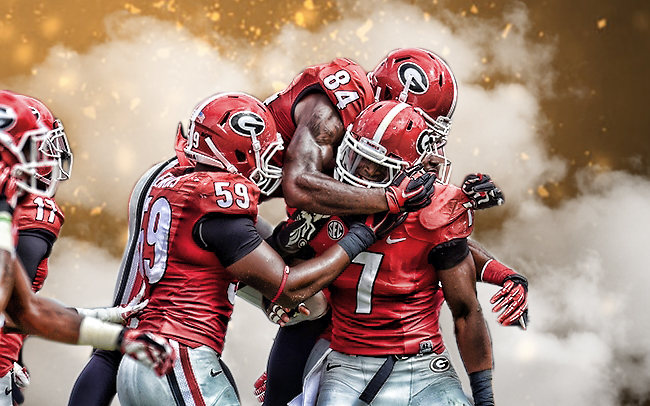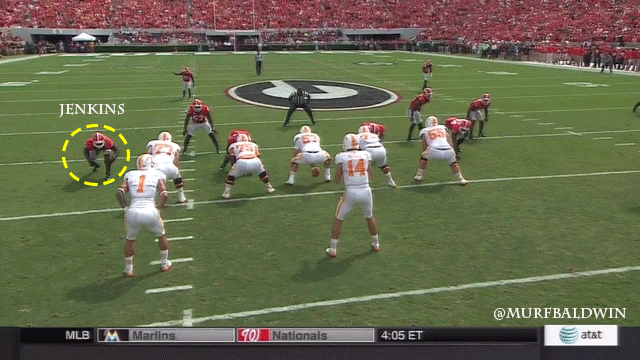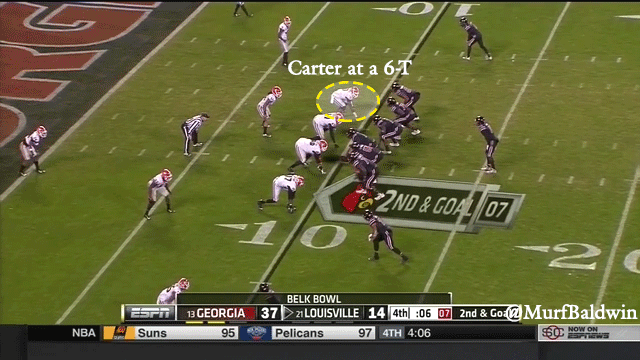Georgia Football: Why a 4-3 defense could best utilize the SEC's top pass rush
In part two of my analysis on the University of Georgia defense and its personnel, I will examine how a loaded front seven could become lights out with just a slight tweak in its deployment.
If you missed the initial part of this two-part series, I explained how I believe UGA isn’t recruiting the type of personnel it takes to effectively run a 3-4-based scheme. I also explained how the University of Alabama, who Georgia has undoubtedly mimicked, has mastered recruiting to that particular scheme and have a plethora of notable selections in recent drafts to support that theory.
Bama is usually equipped with a shade who is north of 330 pounds, quite a few 5-techniques who are around 300 pounds but can still play the pass as well as they play the run and a couple of inside linebackers who are adept at the stack-and-shed technique and can also play in reverse.
UGA has always been stacked with a similar amount of talent along the front seven, but it seems as though the personnel was better suited for a 4-3-based defense. Lighter players such as Ray Drew would’ve wreaked havoc as a gap penetrator, but was usually charged with the task of manning each gap beside him, while LBs Ramik Wilson and Amarlo Herrera struggled to defeat blocks by uncovered linemen.
But there’s a major aspect to a “34” that I purposely glossed over because I believe it’s been the strength of Georgia’s defense even more so than Alabama’s: edge-players.
And with Georgia’s endless supply, now would be the best time to deploy the defense with a true 4-3-based look.
The Line Full of “43” personnel?
There are different variations of “43” and “34” defenses, but for the most part they are defined by one- and two-gap principles, respectively. Having three bigger defenders up front, flanked by two athletic edge-players has produced outstanding results for teams like the New York Jets, Pittsburgh Steelers, Baltimore Ravens and San Francisco 49ers.
New York, Pittsburgh and Baltimore are known for its exotic manufactured-pressure packages where they are solid against the run on early downs and can come from virtually anywhere with pressure on money downs, while the 49ers have routinely just played solid coverage and relied on organic pressure.
But there’s no denying that “43” teams like the New York Giants, New England Patriots, Carolina Panthers and, most notably, the Seattle Seahawks have shot gaps and played the run on the way to the pass to equal success.
There’s really no logical way to answer which style of defense is more effective, but for a UGA team with edge-players the likes of Leonard Floyd, Lorenzo Carter and Jordan Jenkins, playing with an even front means it can get all three on the field at once.
And nobody on the opposing sidelines wants to see that.
Jenkins A Rare Breed
NFL players like Von Miller (6’3″, 250 lbs), Khalil Mack (6’3″, 250 lbs) and Anthony Barr (6’5″, 255 lbs) have caught the eyes of the defensive world by playing an off-the-ball (“Sam”) — position in an even-front scheme on early downs, and then drop down on the line of scrimmage and rush the passer on down-and-distance situations.
These types of players add value in the form of versatility as they can play a plethora of roles while forcing an offense to account for their whereabouts.
Jenkins is very much built in the mode of those type of players but we only get to see him in his normal rush-linebacker role, or as a 5-technique — of all things — in an attempt to keep him on the field when Carter is deployed in sub packages.
If UGA were to line up more in a base “43,” while deploying the 6’6″, 242-pound Carter and the 6’4″, 231-pound Floyd as hand-in-the-dirt defensive ends, it could allow the explosive Jenkins to work his sideline-to-sideline skills as a “Sam.”
It wasn’t until now that I recognized the brilliance of Jenkins as I lamented the fact that he’s the starter over my hometown hero Carter, but the more I lab the film, the more I see why Jenkins received a ton of first- and second-team all-SEC consideration.
To put it simply: He’s a complete football player.
It’s really hard to tell exactly what Jenkins’ best fit is because he excels at pretty much everything. He’s an explosive gap-penetrator who runs through targets as if they are cardboard boxes, but he also has the agility to sift through trash and chase down plays.
In the above sequence, he showed off his explosive inside move on his way to a punishing tackle against Clemson University. These type of plays act as a galvanizer for defenses because it shows how hard your leader is out there working, but it also sets the tone for the team because it’s so darn physical.
As a strong-side LB in a 4-3, his combination of length and athleticism will work well against tight ends and in zone drops — a necessity in a Pruitt scheme. It would be great if Carter could play that role as he’s even lengthier, but not using him as a pure hand-in-the-dirt DE seems like a waste of a classic frame.
Here we see Jenkins making mincemeat of highly touted University of Arkansas left tackle Denver Kirkland. He’s so explosive that he causes linemen to forgo proper technique in an effort to simply get a hand on him.
This sequence shows Jenkins’ ability to vary his pass-rush repertoire and chain moves together. He knows his scouting report says his inside move is as good as it gets, so he’s able to work a variety of moves off the threat of an inside one.
The Vols have a similarly versatile athlete, Curt Maggitt, who floats between “Sam” and edge-rusher and achieved 11 sacks last season in that role.
Expect a huge season from Jenkins.
Carter In The Mold of Jadeveon Clowney?
There will always be a premium placed on edge-players, but especially those in the classic mold of a Julius Peppers or Jadeveon Clowney.
There’s no substitute for having length along a defensive line as it forces QBs to be extremely cautious of their sightlines due to the threat of blocked passes at the line of scrimmage.
The 6’7″, 287-pound Peppers is strong enough to ensure very few breaches out on the edges against the run, but he’s also athletic enough to win at the point of attack with power or finesse moves.
Clowney, 6’5″, 266-pounds, is so athletic that the Houston Texans believed they could convert him to a standup OLB in a “34” despite most players his size excelling schemes where they play closer to the line and generate strength from a three-point stance.
So once an authentic player of this sort comes around, you can bet your bottom dollar NFL execs are taking serious notice. It just so happens that Carter is playing in Pruitt’s scheme where he not only operates predominantly from a two-point stance, but he also has to periodically drop into coverage.
But there’s no denying his pass-rushing ability, as he’s as explosive as you’ll find; his closing speed is something to behold.
And it was only fitting that Georgia’s season would end on a sack by Carter, in a four-man front, in the Belk Bowl against the University of Louisville. Notice how he used his long arms to disengage from the tackle; it’s hard to block someone you can’t get a hold of.
He got a chance to show off his closing speed, which works well chasing down QBs who are trying to detach from the pocket.
I’ve already waxed poetic on how great Floyd is with his unusually quick first step. (Click here to read my analysis of Floyd’s game.) Having a trio of pass-rushers who could all achieve double-digit sacks is unheard of in football.
Employing a 4-3-based scheme would allow for all three to play at the same time while being able to better utilize their skill sets. When you take into account the rest of the talent on the defensive side of the ball, you can very well see how I’ve come to the conclusion that Georgia is the team to beat in the SEC.






